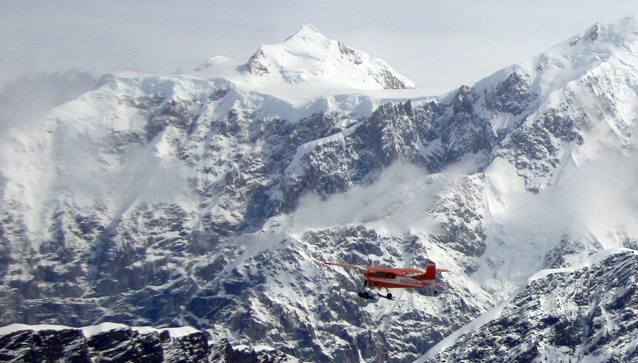
NPS Photo
During a day in June, a pilot skims the sky approaching Kahiltna Pass, allowing sightseers stunning views of glaciers, ice ridges, and Mount McKinley. The pilot circles near the pass, and the plane engines churn with the climb to a safe crossing altitude. Below the plane, climbers at 11,000-foot Camp—acclimatizing before their push to the summit—are expecting a wilderness mountaineering experience in Denali National Park and Preserve. The experience is mostly characterized by silence, broken by the clip of carabiners and the trudge of boots.
This conflict is a park-management challenge.
The Denali National Park and Preserve Aircraft Overflights Advisory Council (Council) was established in 2007 to address such a situation. The group is charged with advising the National Park Service (NPS) on ways to (1) mitigate (reduce) sound impacts from aircraft flights over the park, (2) develop voluntary measures for assuring the safety of passengers, pilots, and mountaineers, and (3) achieve desired resource conditions at Denali as outlined in the Backcountry Management Plan (2006).

NPS Photo
Who is on the Council?
The 12 Council members appointed under the Federal Advisory Committee Act represent the diverse stakeholders involved in and/or affected by aviation in Denali. The composition of the Council carefully balances local, state, and national interests, as well as aviation and non-aviation constituencies. Council members represent these stakeholders:
- Federal Aviation Administration
- United States Air Force
- State of Alaska
- General aviation (private pilots)
- Scenic air tour operators
- NPS-authorized commercial aviation
- Other commercial aviation
- National and state environmental community
- Local environmental community
- Backcountry users
- Local landowners
- Mountaineering/climbing community

NPS Photo
How does the Council approach issues?
The Council provides a forum for ongoing dialogue among stakeholders. Through regular interaction, members become more familiar with the issues and learn to recognize the validity of differing views. The Council’s focus on voluntary measures (rather than regulatory outcomes) provides more latitude to explore a variety of constructive solutions. The mutual respect earned among Council members influences outcomes in ways that are difficult to document, but nonetheless have reduced real and perceived user conflicts.

NPS Photo
How can the public participate?
The full Council meets formally several times a year, with public comment opportunities at each meeting. In addition, as needed, the Council assigns interested members and affected stakeholders to discussion or “roll up your sleeves” working groups. The Council ’s formal recommendations typically follow a vetting process through the informal working groups. For example, the “Aviation Working Group” has been proactive in developing voluntary “best practices” to minimize noise impacts. Another group is discussing how to make these best practices more useful and readily available to non-local pilots. By moving forward in small increments, with ample time for testing and informal vetting, the Council has earned a measure of trust among members and public participants, facilitating increasingly collaborative discussions and solutions.
The Council’s Challenge
- To recommend ways to balance the needs of public safety, public use and access, with protection of the park’s natural resources, wilderness, and soundscape values in a way that is fair and effective.

NPS Photo
Best practices recommendations
The Denali Overflights Council has identified several sound-sensitive areas in the park where visitors engaged in ground activities (e.g., hiking, camping, climbing) conflict with visitors experiencing the park via air tours. To minimize these situations, the Council recommends several best practices to adjust flight patterns when safety permits.
For the example at Kahiltna Pass, where sounds from flightseeing aircraft may impact mountain climbers, the best practice for pilots planning to fly through Kahiltna Pass during the climbing season (late April to early July) is to (1) climb to a safe crossing altitude well before arriving at the Pass, and (2) avoid circling in the pass. This best practice minimizes the sound impact for climbers in the vicinity of the 11,000-foot camp.
In all best practice recommendations, the goal is to separate aircraft from ground-based park visitors to reduce sound impacts to them.
All recommended best practices are subject to the influence of weather, transient traffic operations, and pilot judgment, which may require that pilots deviate from these procedures for pilot and passenger safety.
The Council’s recommendations are subject to refinement and revision as operational experience is gained and as new data are collected. Recommendations may be added for other areas as the Council’s work progresses. Pilots are encouraged to stay informed of new or revised recommendations.
In addition to recommending best practices, the Council provides input to the NPS regarding the park’s efforts to: acquire soundscape data; evaluate the effectiveness of the Council’s overflight recommendations; educate the public about the sources of aircraft sound over the park (e.g., tourism, administrative, search and rescue, general aviation); and consider improved ways to meet desired conditions at Denali.
Last updated: April 21, 2016
